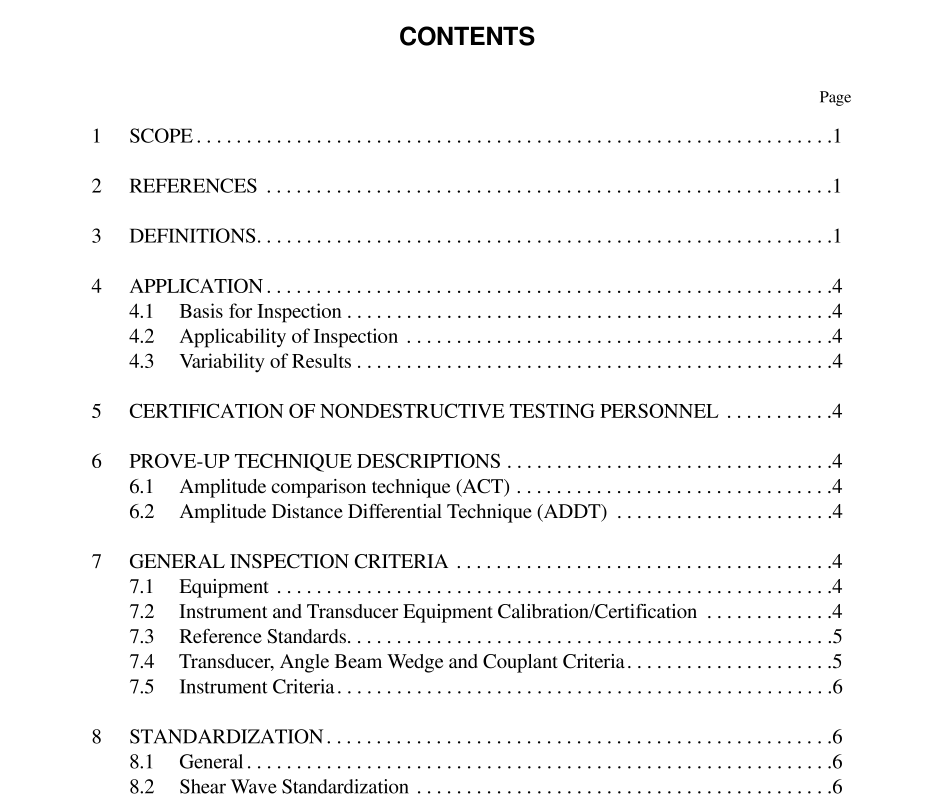API RP 5UE pdf download

API RP 5UE pdf download.Recommended Practice for Ultrasonic Evaluation of Pipe Imperfections
1 Scope
1.1 This recommended practice describes procedures which may be used to “prove-up” the depth or size of imper- fections. Included in this practice are the recommended pro- cedures for ultrasonic prove-up inspection of new pipe using the Amplitude Comparison Technique and the Amplitude- Distance Differential Technique for evaluation of 1) surface breaking imperfections in the body of pipe and 2) surface breaking and subsurface imperfections in the weld area of electric resistance, electric induction or laser welded pipe and 3) surface breaking and subsurface imperfections in the weld area of arc welded pipe. For the purpose of this document, pipe is defined as including casing, plain-end casing liners, tubing, plain-end drill pipe, line pipe, coiled line pipe, pup joints, coupling stock, and connector material. 1.2 Prove-up inspection is a method to evaluate the radial depth of imperfections detected by automated inspection equipment or other nondestructive testing (NDT) tech- nique(s) to determine acceptance criteria compliance with the appropriate API specification. 1.3 The recommended prove-up practices established within this document are intended as a guide, and nothing in this guide should be interpreted to prohibit the agency or owner from supplementing the guide with other techniques or extending existing techniques. 1.4 This RP covers evaluation, a description of inspection methods, calibration and standardization procedures, and inspection personnel requirements for prove-up. 1.5 Appendix A of this document is provided as an over- view to inform the user of the basis for the techniques out- lined in this RP. 1.6 Appendix B of this document provides a procedure for determining if imperfections are surface breaking and a for- mula for calculating the sound path distance for a circumfer- ential or axial scan of a curved surface and a sample look-up table. 1.7 Appendix C of this document is provided as an over- view to inform the user of the specifics for the evaluation of welds with filler metal. 1.8 Appendix D of this document provides a procedure for sizing planar non-surface breaking imperfections from the pipe’s outside surface.
3 Definitions
The following terms are used frequently in the nondestruc- tive testing of pipe: 3.1 A-scan: A method of data presentation utilizing a hor- izontal time-base that indicates distance or time and a vertical deflection from the base line that indicates amplitude. 3.2 active peak memory: The capability of an instru- ment to retain an A-scan presentation while allowing instru- ment controls to be functionally active. 3.3 agency: An entity contracted to inspect new pipe using the methods and criteria specified. 3.4 Amplitude Comparison Technique (ACT): An ultrasonic prove-up method comparing the reflected signals from a reference indicator of known radial depth and an imperfection. 3.5 Amplitude Distance Differential Technique (ADDT): An ultrasonic prove-up method comparing both the distance and amplitude at 50% peak amplitude levels from a reference indicator of known radial depth and an imperfection. 3.6 angle beam: An inspection method in which the angle of incidence or refraction is other than perpendicular to the surface of the test object being inspected. This includes the use of shear waves and longitudinal (compression) waves. 3.7 angle beam block: A specified type of reference standard used for the angle beam method. 3.8 angle of incidence: The included angle between the beam axis of the incident wave and a line perpendicular to the surface at the point of incidence. 3.9 angle of refraction: The included angle between the beam axis of a refracted wave and a line perpendicular to the refraction interface. 3.10 API: Abbreviation for American Petroleum Institute, headquartered in Washington, D.C. 3.11 artificial discontinuity: See reference indicator. 3.12 ASNT: Abbreviation for American Society for Non- destructive Testing, headquartered in Columbus, Ohio. 3.13 ASTM: Abbreviation for American Society for Test- ing and Materials, headquartered in West Conshohocken, Pennsylvania. 3.14 axial scanning: Scanning for imperfections with a transverse orientation. The transducer is aligned with the lon- gitudinal axis of the pipe. 3.15 calibration: The comparison of an instrument with, or the adjustment to, known reference(s) often traceable to the National Institute of Standards and Technology (NIST). 3.16 certification: A written declaration stating compli- ance with stated criteria.









